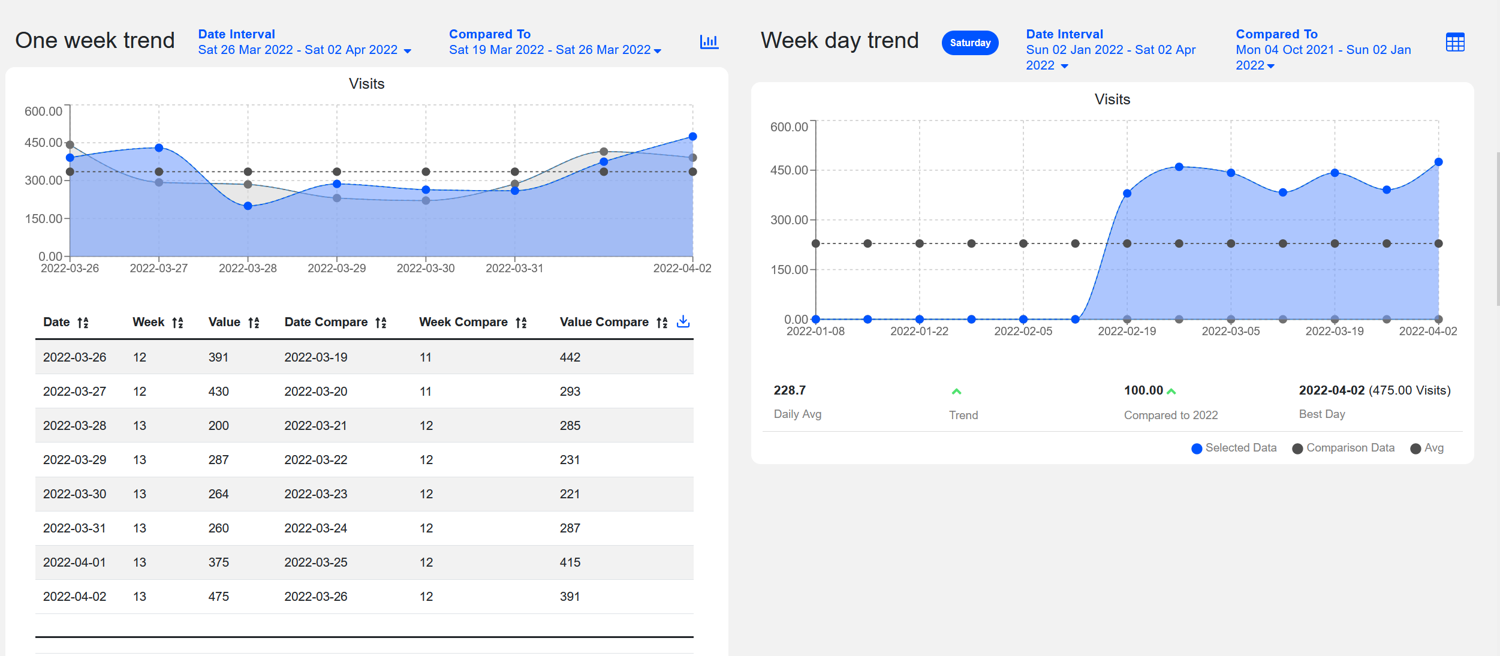Strengths
AGGREGATION OF COMPLEX DATA: Our analysis platform is not limited to the data collected by the Visionarea People Counting system, but can be integrated with multiple external sources (turnover data, receipts, staff turnover, ongoing campaigns, etc.) for a 360-degree view of your business and a perfect understanding of Big Data.
REAL-TIME ANALYSIS AND HISTORICAL ANALYSIS: all data - even the most complex - can be visualised in both historical and real-time mode, enabling the retail manager to react immediately to changes in the scenario and initiate tactical and strategic actions even on the go.
FLEXIBILITY AND PERSONALISATION: thanks to interactive and customisable -and easy-to-use- reports and dashboards, all users, even those with less experience, can visualise data that is really useful for improving decision-making in both operational and strategic areas. All reports are downloadable locally in a convenient CSV format. Our research team provides the client with adequate support and training in the use of the platform and is available for the development of special reports and customised KPIs.
FULL GDPR COMPLIANT: all detection and analysis operations are carried out anonymously and GDPR compliant: in fact, the system detects the presence of visitors, but no identification and no video images are recorded and/or stored by the system itself.
SaaS MODE: access to the MonitorEyes | CMS platform is offered through the Internet in SaaS mode. The user can access the platform with their credentials via a PC, tablet or smartphone with an internet connection.

Analyses Details
Analysis of performance indicators
The monitoring of the performance indices - of the single point of sale and of the entire chain - makes it possible to objectively evaluate the results obtained and to establish the future objectives in a weighted manner. Dashboards and interactive reports break down the sales mechanism into its most relevant components: traffic, receipts, average receipt, staff utilisation, to support management in all choices related to the development and management of a network of sales outlets. The exclusion of shop personnel from the people count also ensures greater accuracy in the calculation of the Conversion Rate.
- Immediate and accurate analysis of conversion rates, margin and traffic of a shop and their correlation with other factors such as weather and drive-to-store campaigns.
- Determining potential turnover based on traffic data and customer purchasing behaviour
- Possibility to compare performance data between different outlets in single or aggregated mode
Marketing Impact Assessment
Knowing the impact that every single communication action and every event has on the flow of visitors and on the performance of the store, you can objectively measure the "net" effect of the activities planned by marketing, distinguishing them from the other factors that contribute to turnover (assortment, customer service...). The punctual analysis of the effectiveness of the different formats used - applicable to individual store micro-areas - provides direct and objective indications for the best allocation of the available budget at chain and shop level.
- Quantitative evaluation (ROI) of in-store advertising and promotional actions and of the different media used
- Evaluation of event traffic and drive-to-store activities
- Determination of passer-by, evaluation of shop window effectiveness (interest rate) and peel-off ratios (ratio of passers-by to shop visitors)
Purchase Paths and Heatmap
By covering the sales floor with a seamless array of sensors, it is possible to gather valuable information on customer behaviour within the shop: from the moment they enter, to the moment they leave. The data collected is processed to generate heat maps that can provide a clear view of where consumers are shopping, helping to improve the layout and display of products, and thus get the most out of every square metre of exhibition space. All data is collected in compliance with privacy regulations as it is not linked to any sensitive user information.
- Analysis of the most frequented routes and average dwell times, with identification of areas of low efficiency (such as queues at checkouts) and congested areas.
- Granular identification of products of interest, thanks to Eye Tracking analysis
- Possibility to quickly perform A/B tests (within the same shop or between different shops) to evaluate the effectiveness of different purchase path layouts or placement of displays and in-store promotions.
- Detection of 'returning visitors': percentage of visitors who return to the same shop or sign (through wi-fi tracking)
Customer Analysis and Segmentation
- It is possible to classify visitors to the shop or a specific area by gender and age group. The system also identifies Purchasing Groups (several individuals who are part of one shopping trip, such as family groups) and can automatically exclude shop personnel.
- Distribution of turnover and visits by gender and age group for a deeper and more accurate understanding of your business
- Visual communication messages within the shop can be changed in real time, based on the profile of visitors
- Historical analysis to understand how the composition of its customer base has changed over time and how it has been influenced by drive-to-store campaigns
Management of personnel
A valid customer service at the point of sale requires product knowledge, competence in sales techniques, listening, empathy, but above all the presence of an adequate number of staff to promptly respond to customer requests (Service Index). The adequate availability of professional staff is essential to increasing the number of buyers, especially in assisted and semi-assisted sales. Our reports help to plan the distribution of staff hours for each shop throughout the chain, based on historical traffic and shop performance data.
- Identification of peak hours and determination of the optimal level of sales personnel per shop and for the entire chain
- Real-time automation in the distribution of personnel for the opening of new checkouts through the analysis of Queues at the Tills
- Automated occupancy management for the entire shop or individual areas, with real-time alerts and display of occupancy, to free staff from manual traffic control tasks